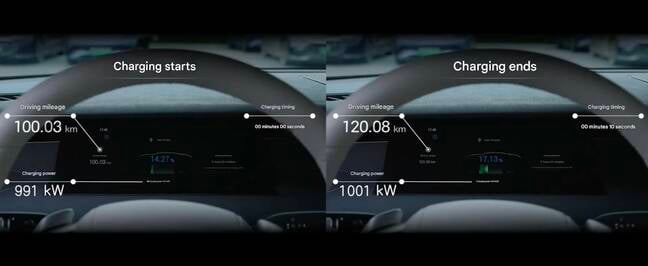China's EV Champ BYD Reveals Super-fast Charging That Leaves Tesla Eating Dust
Chinese electric automaker BYD has announced 1,000-volt supercharging technology it claims can fill a compatible vehicle’s battery in the same amount of time needed to pump fuel into a conventional car.
BYD announced the new so-called Super E-Platform in a video posted to Weibo at the weekend. A brief clip posted by BYD yesterday apparently shows a Super E-Platform-compatible EV using the megawatt-level charging tech to gain 20 kilometers (12 miles) of range in ten seconds.
If BYD’s claims are accurate it’s a game changer for electric vehicles, because charging tech currently tops out with DC fast charging technology that needs 20 minutes to an hour to fully charge an electric vehicle’s empty battery.
Those times are achievable only with chargers rated to 350 kW, but even Tesla Superchargers – one of the three types of technologies that fall into the DC fast charging category – only reach a peak charge rate of 250 kW.
BYD's Super E-Platform could therefore almost triple the speeds of existing EV charging systems.
YMMV
This tech is not exempt from the old auto industry disclaimer - Your Mileage May Vary – because EV charging speeds are rarely constant. Conditions including battery and ambient air temperature can impact charging rates.
BYD didn't share many details about Super E and omitted mention of factors that could slow charging. We've asked the manufacturer for more info; so far, it's staying schtum.
Whatever BYD has created, existing EVs won't benefit from it because the Chinese carmaker said the Super E-Platform only works with two new models it also announced over the weekend – the Han L and the Tang L.
- US proposes ban on Chinese, Russian connected car tech over security fears
- Uber and China's BYD agree deal to roll out 100,000 EV fleet
- EV sales hit speed bump as drivers unplug from the electric dream
- Ford CEO admits he drives a Chinese electric vehicle and doesn't want to give it up
BYD sells its EVs in several European and Asian nations, though hasn’t said when Super-E-enabled cars will be sold outside China.
The automaker doesn’t sell EVs in the USA and it’s not hard to see why: American lawmakers are not keen on Chinese electric passenger vehicles and have suggested banning them ostensibly over surveillance concerns and imposing steep tariffs to make them less affordable for stateside buyers.
The Biden administration adopted policies that effectively ban them from 2027 onward by barring the use of vehicle software or hardware made by Chinese firms in passenger vehicles.
In 2024 Elon Musk, owner of the world's second largest EV manufacturer behind BYD, said he didn't want heavy tariffs on Chinese-made EVs and would prefer competition in an open market.
We asked Tesla to comment on BYD’s tech and haven’t heard back. ®
From Chip War To Cloud War: The Next Frontier In Global Tech Competition
The global chip war, characterized by intense competition among nations and corporations for supremacy in semiconductor ... Read more
The High Stakes Of Tech Regulation: Security Risks And Market Dynamics
The influence of tech giants in the global economy continues to grow, raising crucial questions about how to balance sec... Read more
The Tyranny Of Instagram Interiors: Why It's Time To Break Free From Algorithm-Driven Aesthetics
Instagram has become a dominant force in shaping interior design trends, offering a seemingly endless stream of inspirat... Read more
The Data Crunch In AI: Strategies For Sustainability
Exploring solutions to the imminent exhaustion of internet data for AI training.As the artificial intelligence (AI) indu... Read more
Google Abandons Four-Year Effort To Remove Cookies From Chrome Browser
After four years of dedicated effort, Google has decided to abandon its plan to remove third-party cookies from its Chro... Read more
LinkedIn Embraces AI And Gamification To Drive User Engagement And Revenue
In an effort to tackle slowing revenue growth and enhance user engagement, LinkedIn is turning to artificial intelligenc... Read more


